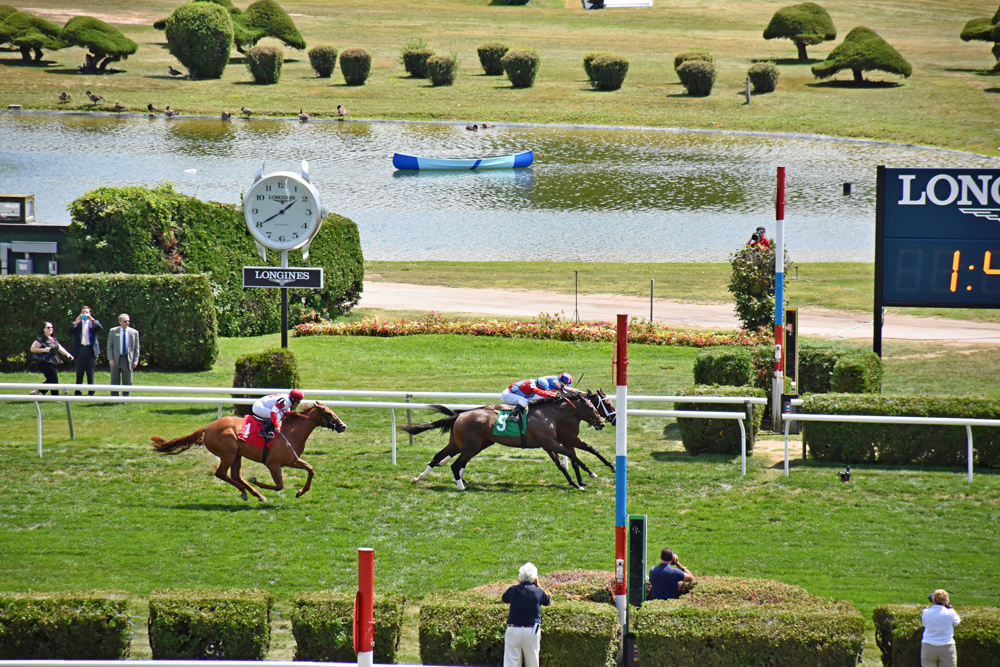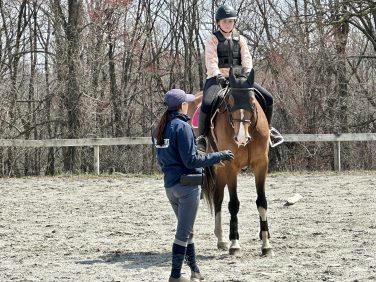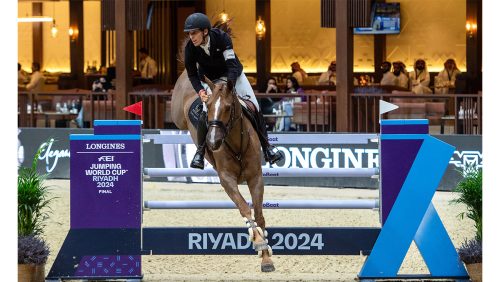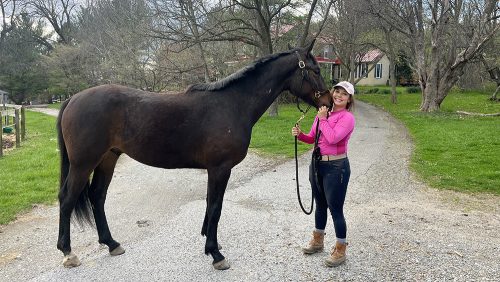Last year when I became aware of the “America’s Most Wanted Thoroughbred” contest, I called Steuart Pittman of Dodon Farm Training Center (organizer of the event) and spoke to him about Heritage Farm training a horse in 2015.
I searched for a prospect, but I could not find one that was suitable—sound enough, the right sized, the right type. I was even able to get a few horses on trial, but still no match.
When I purchased Bold Charger, I was not considering bringing him to Kentucky to this year’s Thoroughbred Makeover event. Some of the horses that will be competing have been in training since January. My horse arrived at my farm on July 24.
He was a purchase, not a rescue. He was not at risk for slaughter; he was in good health and good care. I bought him from Sarah Nelson, who operates Gables Run Equestrian Center. “William” did live out most of the time, so he was thin, not scary thin, but Thoroughbred live outside thin.
I have to say when I dealt with Sarah I could tell she was a good horse person—everything she told me about him was correct and in detail. When William showed up he was actually nicer than I was expecting. Sarah was aware of Heritage Farm, and when the sale was complete she said she was happy that William was coming to Heritage to be trained and excited for his future.
Sarah told me William was the 42nd Thoroughbred horse she has transitioned/re-purposed in the last five years. I spoke to Steuart Pittman recently about William, and we discussed if I was planning to come to Kentucky in October, but my William is lacking a tattoo!

William at three weeks into his new life.
William has no race starts—his career was ended by an injury before he was tattooed. The makeover event requires a horse be tattooed. Steuart is doing an amazing job bringing awareness and acceptance to the former race horse. This is so important, and I feel a calling to this movement and want to help support it and encourage it. I plan to attend the Makeover to support and cheer on Steuart and see all of the OTTB horses compete this fall.
There are many reasons why I became interested in finding a young Thoroughbred to train and develop as a show horse or sport horse. My start with show horses began with horses off the track. If these horses were not available I would not have been able to ride or own a horse; I would not have been able to afford it. Growing up, my family was not wealthy and horses were so foreign to my parents. The story is the same for so many others as well—many of the training staff at our farm had a Thoroughbred horse when they were junior riders.
Three weeks have passed since William got off the trailer at Heritage Farm. When he arrived, you could tell he spent more time in a field than a stall. This actually was a good thing—the all important “let down” process had happened. He had had time to be horse and chill out and heal from a tendon injury.
ADVERTISEMENT
It’s very important for me that a horse is well behaved at my farm. Heritage Farm is a busy place, so a young horse off the track could be an issue if they are not behaved; a hot type would be difficult to manage. I was interested in William for a lot of reasons, but most importantly the fact that when I watched videos of him, I noticed there were other horses in the ring—traffic—and he was unfazed by horses going past him or hacking at the same time. For me this was big. It meant he could fit in.
The process begins: Let’s talk about care and training, first new shoes and worming. William lost a shoe on arrival, and I noticed he was shod in front only and in aluminum. While I waited for our blacksmith to come, I wormed William with a double dose of Panacur.
I had him shod in steel shoes all the way around. Our blacksmith is Michael Boylan, who is a top farrier. I was curious about his reaction to my new project. He came on a Monday to shoe him and said, “You know, that’s going to be a good horse. He is smart and well behaved!” Michael is a Thoroughbred fan, and he has had a few off-the-track horses himself and likes these projects.
OK, shoes on, turnout and riding! William is used to be outside, so turnout is easy. He doesn’t run, he just eats grass and rolls. This is perfect. The last thing I need is a young horse galloping around at top speed. It’s an easy way to get hurt and get the others horses excited. I make sure William is turned out for a minimum of two hours prior to being ridden. I don’t want him ridden without turnout first; that doesn’t make sense.
His first rides went OK. He looked green and weak, but he remained quiet and well behaved. It’s all about the basics now—walk, trot and canter—we are not jumping him yet.

I started with a loose ring snaffle the first week, and then switched to a hard rubber snaffle ring bit; this gave him a little more lift and kept him from leaning on the bridle at the canter. These training rides are about going at the right speed, the right tempo, and in the right shape. I am taking it slow with him. I want William to get broke on the flat and develop muscle at the same time.
William is a 4-year-old, so he is ready for this type of training in short training rides. I don’t want to get him too fit, so I keep these rides to approximately 20 minutes. We always start with a long walk. Lindsey Baker is riding him for me, and she’s doing a great job with William. She is a good rider with good feel and has ridden Thoroughbreds before.
Last weekend my wife Joanne and I did our annual weekend in Saratoga, N.Y. We love it there. The track and the town are so beautiful, and it’s all about Thoroughbred horses, race horses. We got to spend time with our dear friend Will Phipps, who is our shipping agent. He works for Brook Ledge Horse Transportation.
While in Saratoga I got to meet Penny Chenery, who bred and raced the famed Secretariat.
ADVERTISEMENT

Meeting the lovely legend Penny Chenery
As I watched the races I kept thinking of what an athletic effort this is for a horse. I watched all of the races on Saturday and five of the races on Sunday before heading home. I took notice of two races for 2-year-olds—these are babies in my mind. One of those races was for fillies on the turf, and the distance was a little over a mile—these were top quality 2-year-old fillies, and that’s a real distance.

I was thinking, what would a 2-year-old sport horse baby be doing at this age? Not too much at all. Those 2-year-olds run fast , very fast—so different than hunters and jumpers!
So we will continue with William and instead of asking him to go fast it will be slow and steady!
Michael Dignelli is the newest blogger to join the Chronicle’s string of talented writers: Michael Dignelli. Along with his brother, Andre, Michael co-owns Heritage Farm in Katonah, N.Y., where multiple talented hunter/jumper junior stars have learned to ride. Michael manages the daily operations and business of Heritage and lives on the farm. He grew up riding and showing alongside Andre and will be sharing his experience of developing an off-the-track Thoroughbred prospect.















